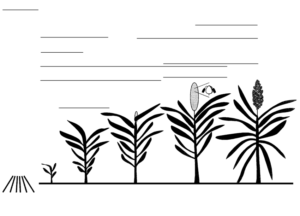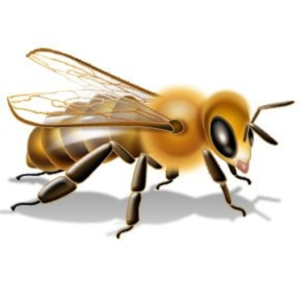Download the full PDF Publication
Sorghum production: An integrated approach
Sorghum is a leading crop commodity in Texas, with about 1.9 million acres planted annually. The crop’s low production costs and high tolerance to heat and drought stress minimize the risks associated with crop production in Texas, making sorghum an attractive alternative to other row crops. Sorghum is also an important rotation crop, which helps control weeds, diseases, and insect pests. However, the low risk of growing sorghum is often offset by low commodity prices and limited yield potential on dryland or marginal production acres.
To meet production goals and maintain profits, growers need to adopt an integrated approach to managing insect and mite pests on sorghum. Integrated pest management (IPM) takes advantage of all appropriate pest management strategies, including the judicious use of pesticides. Well-implemented IPM programs include several cultural practices that reduce pest damage:
• Ensuring that the soil has enough nutrients
• Planting hybrids with resistance to pests
• Planting at the optimum time
• Rotating crops
• Destroying crop residues
The benefits of IPM include a healthier environment for people in rural and urban communities; reduced harm to nontarget organisms, many of which are important for pest management; and the achievement of yield goals while minimizing production costs.
This guide will explain insect pest biology, damage, and management options for grain sorghum production. Management of insect pests attacking sorghum grown for forage and hay is presented in the publication Managing Insect Pests of Texas Forage Crops, which is available from the Texas A&M AgriLife Bookstore at http://agrilifelearn.tamu.edu.
Sampling fields to make insect-control decisions
To determine how severe an infestation is and whether you need to apply insecticide, sample insects and mites in the field. Insect pest numbers can change rapidly. Inspect the sorghum at least once a week, especially during critical times when insect pests are likely to be present (Fig. 1). Record the information you collect during each field inspection to determine changes in insect abundance and plant damage.

The number of samples needed depends on the size of the sorghum field, the growth stage of the plant, and the uniformity and severity of the infestation. Because insect pests are seldom distributed evenly in a sorghum field, examine plants from all parts of the fields. Avoid checking only the borders.
Growers can estimate the abundance of most insects in sorghum by examining some of the plants and plant parts. Randomly select and carefully inspect plants to detect insect pests and associated damage. During the inspection, consider other factors such as predators, parasitized aphids, and plant growth stage and condition.
Some insects, especially those infesting sorghum grain heads, are effectively sampled by using the “beat-bucket” method:
1. Shake the grain sorghum heads vigorously into a 2½- to 5-gallon bucket, where you can see and count the bugs more easily.
2. Sample at least 30 plants from a field. In fields larger than 40 acres, take at least one sample per acre.
3. Because insect pests that live in the soil are hard to control once the crop has been planted, most need to be sampled before planting.
Economic injury level
The economic injury level is the abundance of an insect pest or the amount of plant damage that justifies applying insecticide. The economic injury level is used to develop the action level, or economic threshold. The economic threshold is always lower than the economic injury level. Acting early can help prevent the pest from causing economic loss and allow time to implement a management plan, such as an insecticide application or early harvest.
Although economic thresholds in this publication are based on research, consider them only guidelines because environmental and crop conditions can influence economic thresholds from year to year and region to region.
Insecticides
Applying insecticide is often the only practical way to control insect and mite pests that are at or near damaging levels. The key disadvantages of insecticides are their cost and broad toxicity to beneficial insects. Many of these chemicals can harm insects and spiders that feed on insect pests in and near the crop, leading to secondary pest outbreaks or pest resurgence. To minimize these problems, use the insecticide that is the least toxic to the pest’s natural enemies. Other factors to consider when buying insecticide are its cost and effectiveness.
Apply insecticide only when necessary to prevent economic loss. Otherwise, the cost of control can exceed potential benefits. Use economic thresholds, if available, to consider the cost of control and market value of the crop.
Soil insecticide treatments
Insecticides for controlling some pests that live in the soil can be applied before the crop is planted, at planting, or as a side-dress application. Choose a formulation—granular or liquid—that is appropriate for the target insect and the equipment available.
Preplant row treatment requires special equipment to incorporate the insecticide to a depth of 2 to 4 inches. In fields planted on raised beds, make row treatments during or after bed formation. Further cultivation or bed shaping changes the position of the insecticide in the row. Follow the label directions for placement of the insecticide in the row.
To apply insecticide to the soil at planting, use row band or in-furrow applications:
1. Choose the technique according to the pest insect and the insecticide label.
2. Mount the granular applicator spout or spray nozzle just behind the opening plow or disc opener and in front of the covering shovels or press wheel.
3. Adjust the spouts or nozzles to make the treatment band 6 to 8 inches wide, treating the seed furrow as well as the covering soil.
4. Incorporate the insecticide with covering shovels, short parallel chains, loop chains, press wheels, finger tines, or other suitable devices.
Do not apply insecticides directly on seed unless the label clearly describes that use. Doing so usually reduces seed germination.
Insecticide seed treatments
Insecticides applied directly to seeds to control pre- and post-emergent insect pests are called insecticide seed treatments. Seed treated with any pesticide must be dyed an unnatural color to distinguish it from untreated grain. The color is added to prevent unintended use as oil, food for people, or feed for animals. The pigments may change the seed texture and movement in planters during planting operations. The seed bag will offer suggestions on talcs or other flowing agents to mix with the seed.
The container (such as the bag or a center flow container) must carry labels that include:
• A notice that the seeds have been treated
• The commonly accepted chemical name of the applied substance
• The application rate
• A caution statement if the treatment substance can harm humans or other vertebrates if it remains on the seed
• A statement with the words “Warning—poison treated. Do not use for food, feed, or oil purposes.”
Before handling seed treated with any pesticide, read and follow the directions on the label.
Some seed companies package seed treated with insecticide; others treat seed on request. Although you or another third party could apply a seed treatment, consult the seed dealer before treating purchased seed. Third-party application of a seed treatment may nullify any implied warranty for the seed.
Foliar application of insecticides
Some insecticides discolor the foliage of certain sorghum hybrids. If used on susceptible hybrids, the chemicals could damage the leaves extensively, reducing yields. Read the label carefully before using an insecticide. If you do not know whether the sorghum is susceptible to the insecticide, consult the insecticide manufacturer or seed company. Follow the instructions on the container label carefully to avoid hazards to the applicator, wildlife, and the environment.
Controlling some insect pests requires that you completely cover the plants with insecticide. Complete coverage can be challenging if dense canopies have formed because of hybrid leaf structure and narrow row spacing. To ensure good coverage, consider a high spray volume per acre—no less than 10 GPA and preferably 15 GPA for ground application—to move the insecticide through the canopy and onto the lowest leaves.
Other ways to increase insecticide penetration include selecting appropriate nozzles, lowering the boom to just above the crop surface, slowing the ground application equipment, and, when appropriate, increasing pump pressure. Calibrate the sprayer carefully to ensure that you apply the recommended amount of insecticide.
Protecting bees and other pollinators

Honeybees and other insect pollinators forage in sorghum fields for the pollen in flowering sorghum as well as flowering weeds in and around fields. Honeybees also collect the sugary honeydew deposited on sorghum leaves by aphids. When possible, use pesticides that are less toxic to bees. Most of the insecticides listed in this publication are highly toxic to bees. Exceptions include Sivanto Prime and Prevathon.
Some insecticides kill bees when they contact the chemical residues on or in plants. Adopt these practices to help prevent bee poisoning:
• Apply insecticides late in the evening or at night when bees are not foraging in the field.
• Avoid pesticide drift onto bee colonies. During hot evenings, bees often cluster on the front of their hives. Pesticide drift onto clustering bees can kill many bees.
• Avoid insecticide drift onto blooming plants around the field.
• Make sure that the producer, applicator, and beekeeper cooperate closely to minimize bee mortality.
For directions and restrictions on protecting bees and other insect pollinators, read the “Directions for Use” section of the product label. New labels include this information in a bee advisory box highlighted by the bee icon (Fig. 2).
Inbred lines for hybrid seed production
Compared to hybrids, inbred lines used to produce sorghum hybrid seed have lower economic thresholds and greater risk of foliar insecticide sprays injuring the plants (being phytotoxic). The thresholds are lower in seed-production fields because of the crop’s higher value, its increased susceptibility to damage by insecticides and insect pests, and the greater damage caused by insects that reduce seed quality and germination.
To minimize these problems, regularly monitor fields producing hybrid seed. Before applying an insecticide, check the label carefully, and consult the manufacturer and seed company about possible phytotoxicity.
Endangered Species Act
The Endangered Species Act is designed to protect and aid in the recovery of animals and plants that are in danger of becoming extinct. Because of this act, restrictions have been set on the use or application methods of many pesticides in designated biologically sensitive areas. These restrictions are subject to change. To learn what restrictions apply to your area, read the sections on environmental hazards and endangered species on product labels, and contact the local office of the U.S. Fish and Wildlife Service. Regardless of the law, pesticide users can be good neighbors by knowing how their may affect people and the natural environment.
